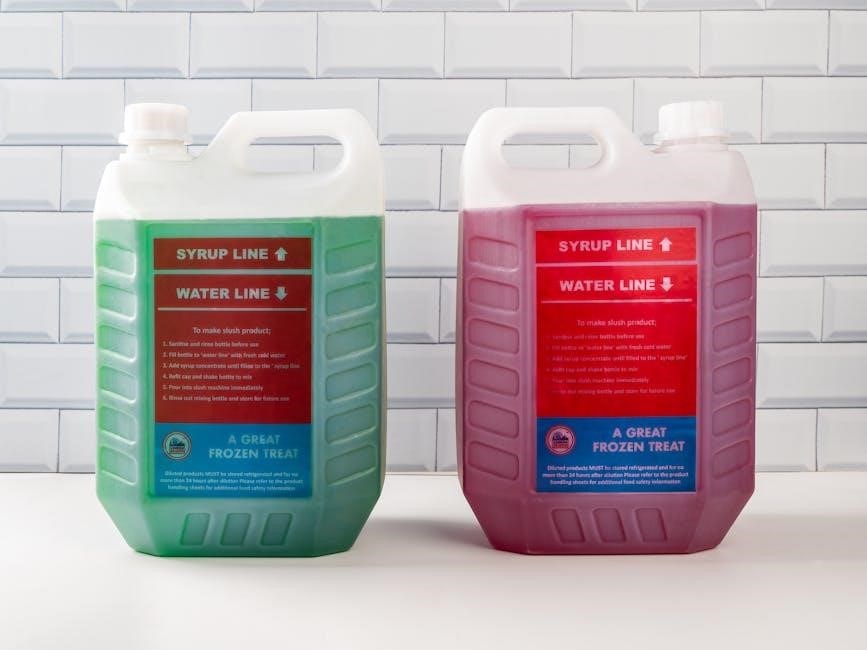Welcome to the Krups Coffee Grinder Instruction Manual, your guide to mastering precise coffee grinding. Explore models like GVX212 and F203, designed for optimal flavor and ease of use.
1.1 Overview of the Krups Coffee Grinder Models
Krups offers a range of coffee grinder models, including the GVX212 and F203, designed for precision and ease of use. These models feature sleek designs, multiple grind settings, and robust construction, catering to both casual and avid coffee enthusiasts. The GVX212 is ideal for various brewing methods, while the F203 provides a compact, user-friendly experience for daily grinding needs.
1.2 Importance of Reading the Instruction Manual
Reading the instruction manual is crucial for safe and effective use of your Krups coffee grinder. It provides essential safety precautions, assembly instructions, and operational guidelines. Understanding the manual ensures optimal performance, prevents damage, and helps troubleshoot common issues. It also highlights maintenance tips to preserve the grinder’s longevity and maintain consistent coffee quality. Always refer to the manual before first use and for ongoing care.
Safety Precautions and Electrical Information
Ensure safe operation by following essential guidelines, such as avoiding water immersion and keeping children away. Understand electrical requirements and precautions to prevent shocks or damage. Regular inspections of cords and components are vital for prolonged use and safety.
2.1 Essential Safety Guidelines
To ensure safe operation, avoid immersing the grinder or its parts in water. Keep children away and never operate the device near water sources. Avoid overloading the grinder, as this can cause mechanical issues. Always unplug the grinder before cleaning or performing maintenance. Regularly inspect the power cord for damage and ensure all components are securely assembled before use. Follow these precautions to prevent accidents and prolong the grinder’s lifespan.
2.2 Special Cord Set Instructions
Always use the original cord provided with your Krups coffee grinder. Never submerge the cord, plug, or grinder in water or liquid. Avoid overheating by ensuring proper ventilation. If the cord is damaged, stop use immediately and contact Krups customer service. Use the grinder on a dry, stable surface and ensure the voltage matches your region’s standards to prevent electrical issues. Replace damaged cords only with approved replacements.
2.3 Electrical Safety Tips
Always unplug the grinder before cleaning or servicing. Avoid using damaged cords or plugs, as they pose fire or shock risks. Keep the grinder away from water sources to prevent electrical hazards. Ensure the grinder is placed on a stable, dry surface. Never touch electrical parts with wet hands. Regularly inspect the cord and plug for wear and tear, replacing them if necessary to maintain safety and performance.

Components and Features of the Krups Coffee Grinder
The Krups Coffee Grinder features a burr grinder, bean container, and ground coffee container. It offers multiple grind settings for precise control over coffee texture and flavor.
3.1 Key Parts and Their Functions
The Krups Coffee Grinder includes a bean container for holding coffee beans, grinding burrs for consistent grinding, and a ground coffee container. The control panel adjusts grind size, while the motor ensures precise operation. These components work together to deliver optimal grinding performance, ensuring fresh and flavorful coffee. Regular maintenance of these parts is essential for longevity and consistent results.
3.2 Understanding the Grind Size Settings
The Krups Coffee Grinder offers adjustable grind size settings, ranging from fine to coarse. These settings are optimized for various brewing methods, such as espresso, cappuccino, and drip coffee. The precise grind size ensures the best flavor extraction. Micro adjustments allow for fine-tuning, enabling you to customize the grind to suit your preferred coffee type and brewing technique for the perfect cup every time.

Assembly and Initial Setup
Begin by unpacking and inspecting all components. Follow the manual to assemble the grinder correctly. Ensure all parts are securely aligned and tightened for proper function.
4;1 Unpacking and Preparing the Grinder
Unpack your Krups coffee grinder carefully, ensuring all components are included. Inspect for any damage. Before first use, read the manual thoroughly. For models like GVX212 and F203, ensure the grinder is placed on a stable surface. Always unplug before cleaning and avoid immersing electrical parts in water. Proper preparation ensures optimal performance and safety.
4.2 Assembling the Grinder Components
Align the grinder components as per the manual. Secure the burrs and bean container tightly. Plug in the device and test with a small amount of beans. Ensure stability and proper alignment for even grinding. Always unplug before assembling or cleaning to avoid accidents. Follow model-specific instructions for GVX212 or F203 to ensure correct assembly and optimal performance.

Operating the Krups Coffee Grinder
Press the power button to start grinding; Adjust the grind size using the dial. For espresso, use a finer setting. Models like GVX212 offer precise control.
5.1 Step-by-Step Grinding Instructions
Plug in the grinder and ensure it’s stable. Add coffee beans to the hopper, adjusting quantity as needed. Select the desired grind size using the dial. Press the power button to start grinding. The process will stop automatically once complete. For consistent results, refer to the grind size chart in your manual or experiment with micro-adjustments for precision. Always ensure the bean container is not overfilled for optimal performance.
5.2 Customizing the Grind Size for Different Coffee Types
Adjust the grind size based on your brewing method. Fine grinds suit espresso, medium for drip coffee, and coarse for French press. The Krups grinder offers multiple settings and micro-adjustments to tailor the grind for optimal extraction. Experiment with different sizes to find your perfect cup, ensuring the best flavor for your preferred coffee type. Refer to the manual for specific guidance on grind size customization.

Maintenance and Cleaning
Regularly clean your Krups coffee grinder to maintain performance and hygiene. Empty the grounds container after use and wipe with a dry cloth. For deep cleaning, use a soft brush and avoid liquids. Refer to the manual for detailed maintenance tips to ensure longevity and optimal functionality of your grinder. Consistent upkeep ensures fresh, flavorful coffee every time.
6.1 Daily Cleaning Routine
For daily maintenance, unplug the grinder and empty the grounds container. Wipe the exterior with a dry cloth to remove residual coffee oils. Use a soft brush to clean the grinding chamber and burrs, ensuring no grounds remain. Avoid using water or liquids, as they may damage electrical components. Regular cleaning prevents mold growth and keeps your grinder in optimal working condition for consistent flavor.
6.2 Deep Cleaning and Maintenance Tips
Perform a deep clean every 1-2 months by disassembling the grinder and soaking removable parts in warm, soapy water. Scrub burrs with a soft brush to remove oil buildup. Reassemble and run a grind cycle with rice to absorb any residue. Regular descaling ensures optimal performance and prevents clogging. Always refer to the manual for specific disassembly instructions to avoid damage to internal components.

Troubleshooting Common Issues
Address common problems like clogged grinders or uneven grinds by cleaning burrs and ensuring proper bean feeding. Regularly empty the grounds container to maintain performance and flavor consistency.
7.1 Resolving Grinding Issues
Common grinding issues include clogged burrs, uneven grinds, or the grinder not turning on.
To resolve these, clean the burrs with a dry brush, ensure proper bean feeding, and check for blockages.
If the motor stops, unplug the grinder, empty the grounds container, and restart.
For inconsistent grind size, adjust the grind settings and ensure the grinder is placed on a stable surface.
Regular cleaning and maintenance can prevent most grinding issues.
- Clean burrs regularly to avoid clogs.
- Ensure beans are evenly fed into the grinder.
- Check for blockages in the grinding chamber.
7.2 Addressing Electrical or Mechanical Problems
If your Krups coffee grinder experiences electrical or mechanical issues, start by unplugging it and checking the power cord for damage.
Ensure the outlet is functioning properly and verify that the grinder is assembled correctly.
If the motor stops suddenly, allow it to cool before restarting.
For unusual noises or vibration, check for misaligned parts or obstructions.
Contact Krups customer support if issues persist.
- Check the power cord and outlet for connectivity issues.
- Ensure all parts are securely and correctly assembled.
- Allow the motor to cool if it overheats.

Coffee Grinding Tips and Best Practices
For optimal flavor, use freshly roasted beans and store them properly. Experiment with grind sizes for different brewing methods and clean the grinder regularly for consistency.
- Choose high-quality beans for the best taste.
- Adjust grind size based on brewing technique.
- Store ground coffee in an airtight container.
8.1 Choosing the Right Coffee Beans
Selecting high-quality coffee beans is essential for optimal flavor. Opt for freshly roasted beans and consider their origin for unique taste profiles. Lighter roasts offer brighter acidity, while darker roasts provide richer, bolder flavors. Store beans in an airtight container to preserve freshness and aroma. Experiment with single-origin or blended beans to find your perfect match for any brewing method.
- Freshness is key for vibrant flavors.
- Light roasts suit pour-over, while dark roasts are ideal for espresso.
- Store beans in a cool, dry place to maintain quality.
8.2 Storing Ground Coffee for Optimal Flavor
To preserve the flavor and aroma of ground coffee, store it in an airtight container in a cool, dark place. Avoid exposure to moisture, heat, and light, as these can degrade quality. For longer storage, consider freezing in an airtight bag or container, ensuring minimal air exposure. Use within a week for optimal freshness and flavor retention.
- Use glass or ceramic containers to prevent odors.
- Freeze for up to two months for extended freshness.
- Grind only what you need to minimize storage time.

Advanced Features and Customization
Explore advanced features like micro adjustments for precision grinding and customizable settings to suit your brewing preferences. Optimize flavor extraction with tailored grind sizes for espresso, cappuccino, and more.
9.1 Micro Adjustments for Precision Grinding
The Krups grinder offers micro adjustments, allowing precise control over grind size. With a range of 12 grind settings, each with fine-tuning capabilities, you can customize the texture to suit espresso, pour-over, or drip brewing. Achieve the perfect grind consistency for optimal flavor extraction. This feature ensures ultimate flexibility for coffee enthusiasts seeking tailored brewing experiences.
9.2 Using the Burr Grinder for Espresso and Cappuccino
The Krups Burr Grinder is ideal for crafting espresso and cappuccino. With precise grind settings, you can achieve the perfect consistency for espresso crema and cappuccino froth. Use the finer grind sizes for espresso and slightly coarser for cappuccino. Adjustments are easy, ensuring optimal flavor extraction. This feature makes the grinder versatile for specialty coffee drinks, enhancing your home brewing experience.

Model-Specific Instructions
Find detailed guides for your specific Krups coffee grinder model, including GVX212 and F203. Access manuals, troubleshooting, and operation tips tailored to your device for optimal performance.
10.1 Krups GVX212 Model Features
The Krups GVX212 boasts a sleek design and precise grinding technology. It features 12 grind sizes with micro adjustments, ensuring perfect extraction. Designed for coffee enthusiasts, it offers versatility for espresso, cappuccino, and other brewing methods. The burr grinder ensures consistent results, while its compact build fits seamlessly into any kitchen. Explore its advanced features for tailored coffee experiences.
10.2 Krups F203 Model Operating Guide
The Krups F203 is a compact and user-friendly coffee grinder designed for home use. It features a powerful grinding mechanism with multiple grind settings to suit various brewing methods. The grinder includes a safety feature that automatically shuts off when the lid is removed. Easy to clean and maintain, the F203 is ideal for daily use, ensuring freshly ground coffee with minimal effort and optimal flavor.
Mastering your Krups coffee grinder ensures optimal flavor and performance. For further assistance, visit Krups’ official website or consult customer support for detailed manuals and troubleshooting guides.
11.1 Final Tips for Optimal Performance
For consistent results, clean your grinder daily and empty the ground coffee container after each use. Store coffee beans in an airtight container to preserve freshness. Experiment with grind sizes and brewing methods to enhance flavor. Regular maintenance ensures longevity. Refer to the manual for troubleshooting or explore advanced features for customization. Happy grinding!
11.2 Accessing Krups Coffee Grinder Manuals Online
Visit the official Krups website to download PDF manuals for your specific coffee grinder model, such as GVX212 or F203. Use the search function to find your model and access troubleshooting guides, FAQs, and detailed instructions. Online manuals are available 24/7, ensuring you can resolve issues or learn new features anytime. Always refer to official sources for accurate information.

































